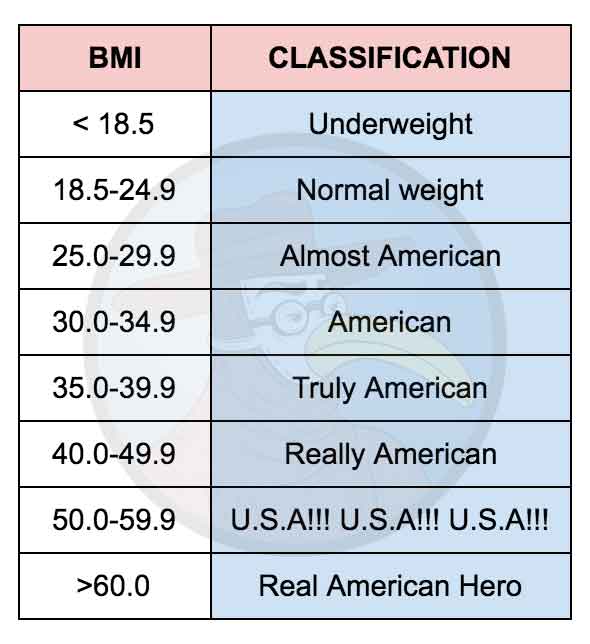GENEVA, SWITZERLAND – The World Health Organization (WHO) has revised its BMI (body mass index) classification system, a simple and widely used method for estimating body fat mass, by replacing the term “obesity” with the word “American.”
“The world thinks of a few things when they think of the United States: superpower, democracy, and obesity,” said Margaret Chan, Director General of the WHO. “In fact, many believe that Captain America isn’t fat enough. With obesity becoming a true epidemic in America, the only way to fight the problem is to embrace it. And have you tried to embrace an obese person? It’s quite challenging.”

The calculation of BMI remains the same: divide a subject’s mass in kilograms by the square of his or her weight. But in addition to measuring body fat mass, body mass index is now a measure of patriotism or “American-ness.” See Figure 8 for values and their new classifications.
The surgical literature has their own classification system, but similar revisions are sure to follow. Severe obesity (BMI of 35.5-39.9) will likely be renamed severe American, morbid obesity (BMI of 40.0 to 44.9) to morbid American, and super obese (BMI 45.0 to 50.0) to super American.
“Americans are redefining obesity as know it,” explained Chan. “It’s already unfair that they do so well in the Olympics, the pinnacle of human fitness. Do Americans also have to dominate the opposite end of the spectrum too? Let others have diabetes, cardiovascular, osteoarthritis, and sleep apnea too!”
Chan makes a point. With no apparent plateauing of the obesity crisis, it isn’t outside the realm of possibility that new BMI classifications are added.
“We’re getting fatter at an alarming rate,” explained CDC Director Dr. Tom Frieden. “In no time we’ll have 13 BMI classes, one for each of the stripes on the American flag. That’s a little more patriotic than we want to get, don’t you think?”







